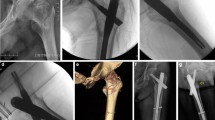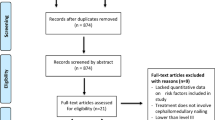Abstract
Introduction
Impingement and penetration of the anterior cortex of the femur have been reported as complications after cephalomedullary nailing. The purpose of this study was to determine factors related to nail impingement in our population of Hispanic patients.
Materials and methods
A non-matched case–control study was carried out and 156 patients who underwent cephalomedullary nailing from 2010 and 2013 were included; 78 cases with anterior cortical impingement and 78 control cases without impingement were documented. Demographic variables and specifications of the nails such as manufacture and radius of curvature were recorded. The presence of impingement, angle of incidence on radiographs—indirect measurement of the femoral bow on the sagittal plane—and nail entry site were determined. Bivariate and multivariate logistic regression analyses were performed to identify the factors associated with cortical impingement.
Results
The distribution by sex corresponded to 87 females (56 %) and 69 males (44 %) with a mean age of 75 years [SD 18.2]. Cortical impingement was presented in 78 cases (50 %) and 6 (3.8 %) patients evidenced penetration of the anterior cortex of the femur. On the bivariate analysis the posterior nail start site is highlighted, which showed a positive association with impingement (OR 4.3; 95 % CI 1.1–36 and p = 0.04). After the multivariate analysis, the factors associated with anterior cortical impingement included female gender (OR 2.2; 95 % CI 1.1–4.6 and p ≤ 0.038), straight nails—short nails—(OR 4.9; 95 % CI 2.2–10 and p ≤ 0.001) and angle of incidence ≥7° (OR 4.9; 95 % CI 2.2–10 and p ≤ 0.001), the latter showing a likelihood of 57 % for impingement, increasing to 90 % with an angle of incidence of 11°.
Conclusions
Posterior entry site should be avoided and an anterior site should be used. Female gender, straight nails and greater angle of incidence of the femur were associated with cortical impingement. A specific intramedullary nail design is needed for the Hispanic population due to high impingement and anterior cortical penetration rates seen with conventional nails. Short curved nails and long nails with a lower radius of curvature are required.



Similar content being viewed by others
References
Sterling RS (2011) Gender and race/ethnicity differences in hip fracture incidence, morbidity, mortality, and function. Clin Orthop Relat Res 469:1913–1918. doi:10.1007/s11999-010-1736-3
Brauer CA, Coca-Perraillon M, Cutler DM et al (2009) Incidence and mortality of hip fractures in the United States. JAMA 302:1573–1579. doi:10.1001/jama.2009.1462
Gullberg B, Johnell O, Kanis JA (1997) World-wide projections for hip fracture. Osteoporos Int 7:407–413
Belmont PJ Jr, Garcia EJ, Romano D et al (2014) Risk factors for complications and in-hospital mortality following hip fractures: a study using the National Trauma Data Bank. Arch Orthop Trauma Surg 134:597–604. doi:10.1007/s00402-014-1959-y
Tay YW, Hong CC, Murphy D (2014) Functional outcome and mortality in nonagenarians following hip fracture surgery. Arch Orthop Trauma Surg 134:765–772. doi:10.1007/s00402-014-1982-z
Rosell PA, Parker MJ (2013) Functional outcome after hip fracture. A 1-year prospective outcome study of 275 patients. Injury 34:529–532
Suhm N, Kaelin R, Studer P et al (2014) Orthogeriatric care pathway: a prospective survey of impact on length of stay, mortality and institutionalisation. Arch Orthop Trauma Surg 134:1261–1269. doi:10.1007/s00402-014-2057-x
Vidal E, Moreira-Filho D, Pinheiro R et al (2012) Delay from fracture to hospital admission: a new risk factor for hip fracture mortality? Osteoporos Int 23:2847–2853
Bojan AJ, Beimel C, Speitling A et al (2010) 3066 consecutive Gamma Nails. 12 years experience at a single centre. BMC Musculoskelet Disord 11:133
Intramedullary Nails (2014) Gamma3 IM Nailing System. Stryker. http://www.stryker.com/en-us/index.htm. Accessed 11 Mar 2014
McCarty LP, Wixted J, Vrahas M et al (2007) Use of the long trochanteric fixation nail for unstable intertrochanteric and subtrochanteric fractures. Ortho J HMS 9:129–133
Femur proximal (2011) TFN with Screw. AO Foundation. https://www.aofoundation.org/Structure/Pages/default.aspx. Accessed 11 Mar 2014
Trauma (2012) Titanium Trochanteric Fixation Nail System (TFN). DePuy Synthes. http://www.synthes.com/Pages/default.aspx. Accessed 11 Mar 2014
Weiser L, Ruppel AA, Nüchtern JV et al (2015) Extra- vs. intramedullary treatment of pertrochanteric fractures: a biomechanical in vitro study comparing dynamic hip screw and intramedullary nail. Arch Orthop Trauma Surg 135:1101–1106. doi:10.1007/s00402-015-2252-4
Roberts JW, Libet LA, Wolinsky PR (2012) Who is in danger? Impingement and penetration of the anterior cortex of the distal femur during intramedullary nailing of proximal femur fractures: preoperatively measurable risk factors. J Trauma Acute Care Surg 73:249–254. doi:10.1097/TA.0b013e318256a0b6
Bazylewicz DB, Egol KA, Koval KJ (2013) Cortical encroachment after cephalomedullary nailing of the proximal femur: evaluation of a more anatomic radius of curvature. J Orthop Trauma 27:303–307. doi:10.1097/BOT.0b013e318283f24
Liu W, Zhou D, Liu F et al (2013) Mechanical complications of intertrochanteric hip fractures treated with trochanteric femoral nails. J Trauma Acute Care Surg 75:304–310. doi:10.1097/TA.0b013e31829a2c43
Collinge CA, Beltran CP (2013) Does modern nail geometry affect positioning in the distal femur of elderly patients with hip fractures? A comparison of otherwise identical intramedullary nails with a 200 versus 150 cm radius of curvature. J Orthop Trauma 27:299–302. doi:10.1097/BOT.0b013e318283f231
Buecking B, Bliemel C, Struewer J et al (2012) Use of the Gamma3™ nail in a teaching hospital for trochanteric fractures: mechanical complications, functional outcomes, and quality of life. BMC Res Notes 5:651. doi:10.1186/1756-0500-5-651
Antegrade nailing (2007) Femur shaft 32-B1 CRIF subtrochanteric. AO Foundation. https://aotrauma.aofoundation.org/Structure/Pages/default.aspx. Accessed 20 June 2014
Joseph N Jr (2006) Film critique of the lower extremity—Part 1. Online radiography continuing education for radiologic X ray technologist. https://www.ceessentials.net/index.php. Accessed 20 June 2014
Joseph N Jr (2006) Film critique of the lower extremity—Part 2. Online radiography continuing education for radiologic X ray technologist. https://www.ceessentials.net/index.php. Accessed 20 June 2014
Hosmer DW, Lemeshow S (2005) Model-building strategies and methods for logistic regression. In: Hosmer DW, Lemeshow S (eds) Applied logistic regression, 2nd edn. Wiley, New York, pp 91–142
Chang SM, Song DL, Ma Z et al (2014) Mismatch of the short straight cephalomedullary nail (PFNA-II) with the anterior bow of the femur in an Asian population. J Orthop Trauma 28:17–22. doi:10.1097/BOT.0000000000000022
Egol KA, Chang EY, Cvitkovic J et al (2004) Mismatch of current intramedullary nails with the anterior bow of the femur. J Orthop Trauma 18:410–415
Casteleiro R, Castaños C. San Martin A et al (1995) Biometría femoral: Curva diafisaria y longitud anatómica. Estudio de las correlaciones. Biomecánica 3:107–111
Zhang S, Zhang K, Wang Y et al (2013) Using three-dimensional computational modeling to compare the geometrical fitness of two kinds of proximal femoral intramedullary nail for Chinese femur. ScientificWorldJournal 2013:978485. doi:10.1155/2013/978485
Maniscalco P, Rivera F, D’Ascola J, Del Vecchio EO (2013) Failure of intertrochanteric nailing due to distal nail jamming. J Orthop Traumato 14:71–74. doi:10.1007/s10195-012-0183-1
Saus N, Mifsut D, Guijarro S et al (2013) Clavo gamma 3 largo en el tratamiento de las fracturas de cadera: Protrusión o perforación de la cortical anterior del fémur a nivel distal. Rev Esp Cir Osteoart 48:22–27
Chang SM, Zhang YQ, Ma Z et al (2015) Fracture reduction with positive medial cortical support: a key element in stability reconstruction for the unstable pertrochanteric hip fractures. Arch Orthop Trauma Surg 135:811–818. doi:10.1007/s00402-015-2206-x
Von Rüden C, Hungerer S, Augat P et al (2015) Breakage of cephalomedullary nailing in operative treatment of trochanteric and subtrochanteric femoral fractures. Arch Orthop Trauma Surg 135:179–185. doi:10.1007/s00402-014-2121-6
Acknowledgments
The authors thank Dr. Andrés González and Dr. Iván Flórez for the epidemiologic support, and Dr. Jaime Leal for contributions to the discussion of the results. Likewise, the authors acknowledge Dr. Alfredo M. López-Yunez, Dr. Julia Escandon and Dr. Anna Spector for editing and proofreading the manuscript.
Author information
Authors and Affiliations
Corresponding author
Ethics declarations
Funding source
No external funding was used.
Ethical standards
(1) The study was approved by both the Institutional Medical Review Board and Ethics Committee of the Hospital Research Center and was performed in accordance with the ethical standards of the 1964 Declaration of Helsinki and its later amendments. (2) Since it was a retrospective study, the need for informed consent was waived by the Institutional Medical Review Board.
Conflict of interest
The authors declare that they have no conflict of interest.
Rights and permissions
About this article
Cite this article
Peña, O.R., Gómez Gélvez, A., Espinosa, K.A. et al. Cephalomedullary nails: factors associated with impingement of the anterior cortex of the femur in a Hispanic population. Arch Orthop Trauma Surg 135, 1533–1540 (2015). https://doi.org/10.1007/s00402-015-2313-8
Received:
Published:
Issue Date:
DOI: https://doi.org/10.1007/s00402-015-2313-8




